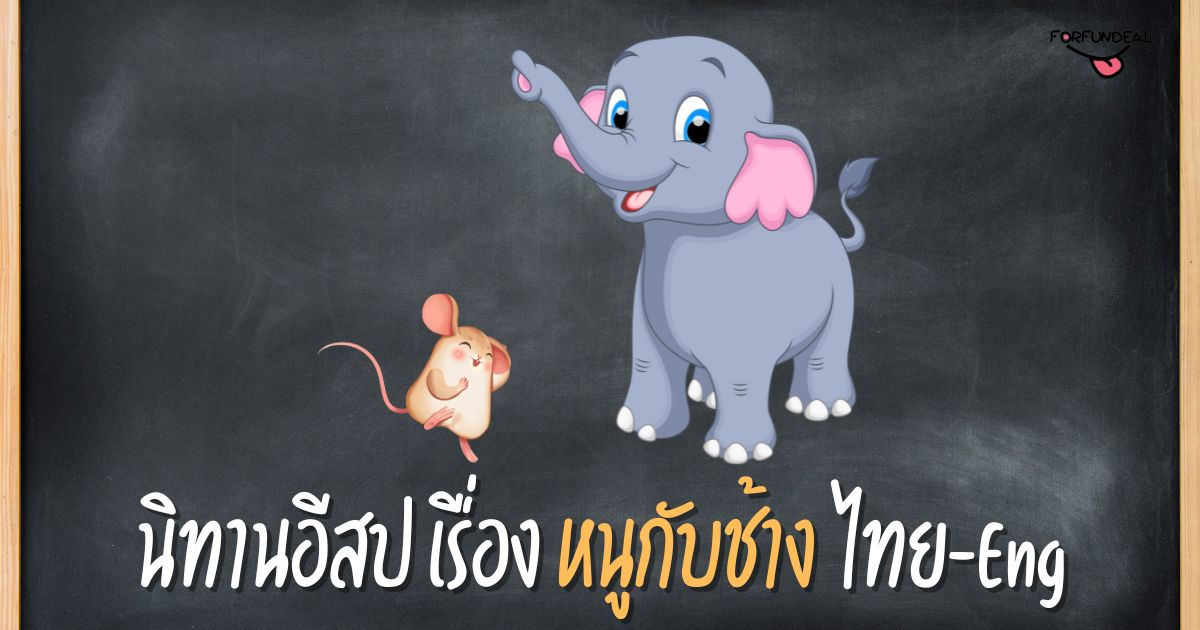“หนูกับช้าง” เป็นนิทานอีสปที่สอนเราถึงคุณค่าในความหลากหลายของชีวิต ทุกคนต่างมีข้อดี ข้อด้อย ที่แตกต่างกัน โดยไม่มีใครสมบูรณ์แบบ เป็นลักษณะที่ยอดเยี่ยมที่ธรรมชาติสรรสร้าง
นิทานอีสปเรื่องหนูกับช้าง
กาลครั้งหนึ่งนานมาแล้ว หนูตัวหนึ่งอาศัยอยู่ในโพรงเล็กๆ ใกล้แม่น้ำ วันหนึ่ง ขณะที่หนูกำลังวิ่งเล่นอยู่ริมตลิ่ง บังเอิญเจอช้างตัวใหญ่เข้า หนูรู้สึกทึ่งกับขนาดและพละกำลังของช้าง
Once upon a time, a rat lived in a small hole near a river. One day, while the rat was scurrying along the riverbank, it came across a mighty elephant. The rat was in awe of the elephant’s size and strength.
เต็มไปด้วยความชื่นชม หนูเข้าไปใกล้ช้างและพูดว่า “โอ้ช้างผู้ยิ่งใหญ่! ความแข็งแกร่งของเจ้าไม่มีที่เปรียบ และการปรากฏตัวของเจ้าเป็นที่นับถือ โชคดีแค่ไหนที่เจ้ามีพลังมากขนาดนี้”
Filled with admiration, the rat approached the elephant and said, “Oh, mighty elephant! Your strength is unmatched, and your presence commands respect. How fortunate you are to be so powerful.”
ช้างตอบด้วยความเฉลียวฉลาดและอ่อนน้อมถ่อมตนว่า “ขอบคุณ หนูน้อย จริงๆ แล้ว หนูมีพละกำลัง แต่พละกำลังเพียงอย่างเดียวไม่ได้กำหนดความยิ่งใหญ่ สัตว์แต่ละตัวไม่ว่าจะตัวเล็กเพียงใด ก็มีคุณสมบัติและคุณูปการที่แตกต่างกันไป”
The elephant, with wisdom and humility, replied, “Thank you, little rat. Indeed, I possess strength, but strength alone does not define greatness. Each creature, no matter how small, has its own unique qualities and contributions.”
หนูได้รับแรงบันดาลใจจากคำพูดของช้าง จึงรู้ว่ามันก็มีจุดแข็งในตัวเองเช่นกัน แม้ว่ามันอาจไม่มีขนาดและพลังเท่าช้าง แต่หนูก็มีความว่องไว เฉลียวฉลาด และปรับตัวได้ มันเข้าใจดีว่าทุกชีวิตมีค่าไม่ว่าจะมีขนาดหรือรูปร่างหน้าตาอย่างไร
The rat, inspired by the elephant’s words, realized that it, too, had its own strengths. While it may not possess the size and power of the elephant, the rat had agility, intelligence, and adaptability. It understood that every living being has value, regardless of their size or appearance.
ตั้งแต่วันนั้นเป็นต้นมา หนูก็ได้ใช้จุดแข็งของตัวเองและมีส่วนร่วมในระบบนิเวศ มันใช้ความคิดที่รวดเร็วในการนำทางผ่านพื้นที่แคบๆ ประสาทสัมผัสที่เฉียบคมในการตรวจจับอันตราย และไหวพริบในการหาอาหารและที่พักพิง
From that day on, the rat embraced its own strengths and played its part in the ecosystem. It used its quick thinking to navigate through narrow spaces, its keen senses to detect danger, and its resourcefulness to find food and shelter.

นิทานเรื่องนี้สอนให้รู้ว่า
“ขนาดและความแข็งแกร่งไม่ได้กำหนดความยิ่งใหญ่ สิ่งมีชีวิตแต่ละชนิดมีจุดแข็งและคุณประโยชน์เฉพาะตัวของตัวเอง ยอมรับความสามารถของคุณ ไม่ว่ามันจะเล็กน้อยหรือแตกต่างแค่ไหนก็ตาม”
- คุณค่าในความหลากหลาย: เรื่องราวเน้นย้ำถึงความสำคัญของการตระหนักและให้คุณค่ากับคุณสมบัติที่เป็นเอกลักษณ์และการมีส่วนร่วมของแต่ละคน โดยไม่คำนึงถึงขนาดหรือรูปลักษณ์ของพวกเขา มันสอนเราว่าความหลากหลายทำให้โลกของเราสมบูรณ์ยิ่งขึ้น และทุกคนมีบางสิ่งที่มีความหมายที่จะนำเสนอ
- ความอ่อนน้อมถ่อมตนและสติปัญญา: การตอบสนองของช้างแสดงถึงความอ่อนน้อมถ่อมตนและสติปัญญา แทนที่จะโอ้อวดความแข็งแกร่งของตัวเอง มันกลับยอมรับคุณค่าของสิ่งมีชีวิตทั้งหมด รวมถึงหนูตัวเล็กด้วย มันเตือนเราถึงพลังของความอ่อนน้อมถ่อมตนและความสำคัญของการตระหนักถึงจุดแข็งของผู้อื่น
- ยอมรับจุดแข็งของตัวเอง: หนูตระหนักว่ามันมีจุดแข็งของตัวเอง ซึ่งมันสามารถใช้เพื่อเติบโตในแบบของมัน เรื่องราวนี้กระตุ้นให้เรายอมรับจุดแข็งและความสามารถของตนเอง โดยตระหนักว่าเราทุกคนมีบางสิ่งที่มีคุณค่าที่จะมีส่วนร่วม
- ความเสมอภาคและความเคารพ: มันส่งเสริมหลักการของความเสมอภาคและความเคารพต่อสิ่งมีชีวิตทั้งหมด สอนให้เราปฏิบัติต่อผู้อื่นด้วยความเมตตา โดยไม่คำนึงถึงขนาดหรือสถานะทางสังคม และยอมรับคุณค่าในตัวของแต่ละคน
- ความเชื่อในตนเอง: การที่หนูเพิ่งค้นพบคุณค่าในตัวเองนั้นเน้นย้ำถึงความสำคัญของความเชื่อในตนเอง มันสอนให้เรามีความมั่นใจในตัวเองและความสามารถของเราแม้ว่าพวกเขาจะแตกต่างจากคนอื่นก็ตาม
“Size and strength do not define greatness; each creature has its unique strengths and contributions to offer. Embrace your abilities, no matter how small or different they may be.”
- Value in diversity: The story highlights the importance of recognizing and valuing the unique qualities and contributions of every individual, regardless of their size or appearance. It teaches us that diversity enriches our world and that everyone has something meaningful to offer.
- Humility and wisdom: The elephant’s response showcases humility and wisdom. Instead of boasting about its own strength, it acknowledged the worth of all creatures, including the small rat. It reminds us of the power of humility and the importance of recognizing the strengths of others.
- Embracing one’s own strengths: The rat realized that it had its own unique strengths, which it could use to thrive in its own way. The story encourages us to embrace our own strengths and abilities, recognizing that we all have something valuable to contribute.
- Equality and respect: “The Rat and the Elephant” promotes the principles of equality and respect for all living beings. It teaches us to treat others with kindness, regardless of their size or social status, and to acknowledge the inherent worth of every individual.
- Self-belief: The rat’s newfound realization of its own value emphasizes the importance of self-belief. It teaches us to have confidence in ourselves and our abilities, even if they may differ from those of others.
โดยสรุปแล้วนิทานเรื่องนี้สอนให้เราเห็นคุณค่าของความหลากหลาย ยอมรับในความแข็งแกร่งของเราเอง ฝึกฝนความอ่อนน้อมถ่อมตนและสติปัญญา ปฏิบัติต่อผู้อื่นด้วยความเสมอภาคและความเคารพ และมีความเชื่อในตนเอง โดยการนำคำสอนเหล่านี้ไปใช้ เราสามารถปลูกฝังความคิดที่เป็นหนึ่งเดียวและมีความเห็นอกเห็นใจมากขึ้น เห็นคุณค่าของสิ่งมีชีวิตทั้งหมดในโลกที่เชื่อมโยงถึงกัน

